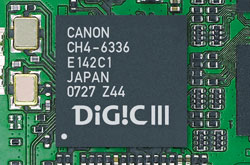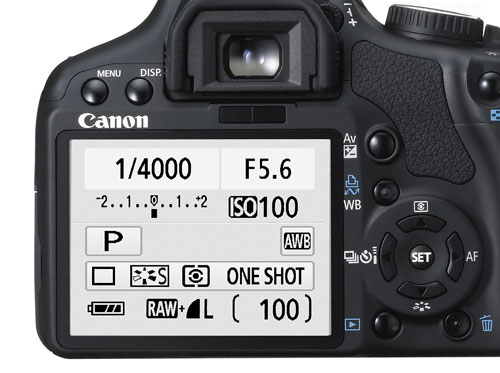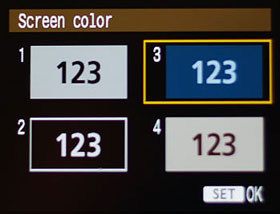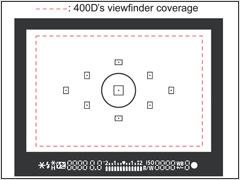Canon XSi: 12.2 Megapixels, Image Stabilized Lens, and Double Live View
by Wesley Fink on May 5, 2008 3:00 AM EST- Posted in
- Digital Camera
XSi Features
Some of the more significant improvements to the XSi were taken from the Canon 40D and the Pro Canons. The processing heart of the XSi is the Digic III which is the same chip used in the 40D.

This endows the Canon XSi with a speedy 14-bit Analog-to-Digital converter. Digic III was widely praised when it was first introduced last fall as dual Digic III processors in the $8000 EOS 1Ds Mark III and a single Digic III in the Canon 40D. Now the entry-level XSi has the same processor as these Canon top-line cameras.

The 3" LCD used on the XSi is the largest LCD currently used on an entry-level DSLR. Others are 2.7" and 2.5". This is also the same 230,000 pixel 3" LCD used on the 40D and the 1Ds Mark III. This is not as finely detailed as the higher-resolution 3" LCD used on the Nikon D300 and the Sony A700, but those are $1800 and $1400 cameras compared to $800 for the XSi body alone. The 3" display can even be customized by choosing one of four color schemes.

Our review of the Sony A350 complained about the horrible .74x magnification and "looking down a tunnel" view of the A350. All of the cropped sensor cameras (i.e. most everything but top Pro DSLRs) are challenged in producing large, bright viewfinders compared to 35mm full-frame cameras.

Canon continues to improve viewfinders - even those in their entry XSi camera. Here you can see the improved view of the .87x magnification XSi compared to the .80x magnification of the XTi and XT viewfinders. The original Digital Rebel from 2003 featured a decent .88x viewfinder that was sacrificed to the size shrink of the Digital Rebel XT model. With the XSi the viewfinder of the entry Canon is back to the magnification of the original Digital Rebel. Brightness also appears to be improved with the XSi the brightest finder of the series.
While the .88x is a welcomed improvement, the new 40D prosumer model has an even better viewfinder with a .95x view. Since the 40D and XSi sensors are the same size (22.2x14.8mm), the viewfinder magnifications are directly comparable. However, comparing the XSi viewfinder to its competitors - the Nikon D60, Sony A350/A300, and Olympus E-510/E-420 - shows the Canon XSi to have the best viewfinder in its class.
The 9-point AF module appears similar to the 9-point AF in the Canon 40D. Working range AF specifications are the same EV range of -0.5EV to 18EV. However, the 40D adds an additional diagonal cross-type sensor with greater precision for f2.8 lenses, providing better support for fast Canon L lenses.
The XSi is the first in the Digital Rebel series to feature a Spot Metering option. Every review has complained about this missing feature since the launch of the original Digital Rebel, and Canon has finally listened. The spot meter is 4% of the viewfinder and available only on the center spot. In the picture above showing the viewfinder, the spot metering area is represented by the circle around the center AF spot. This is also visible in the XSi viewfinder.
ISO Speed Display and Auto ISO
Users have also asked Canon to add ISO speed to the viewfinder display. In the XSi that is finally a reality. Auto ISO is also a more useful feature since it now works over a wider range, at least to 800 in our tests and the auto-selected ISO is also displayed in the viewfinder and on the rear LCD dynamically. However, even in total darkness we could not coax Auto ISO to select 1600, and in the brightest of shooting situations the XSi would not auto select ISO 100.










56 Comments
View All Comments
punchkin - Thursday, May 8, 2008 - link
So the upshot of it is that it is not PRESUMABLY rated at 50,000. You don't know, and pulled a number out of your butt.mikett - Wednesday, May 7, 2008 - link
Can anyone indicate the relative lifespan rating on the XSi vs the 40D?I once recalled that the 40D class ( 20D, 30D ) had a significantly higher rating than the Rebel class and their construction was sturdier but maybe that has changed.
mmusterd - Tuesday, May 6, 2008 - link
In fact in many ways the XSi is a much more exciting new camera than the 40D was when it was introduced just 6 months ago.Well, yes. It means the 40D is dropping in price, and op top of that, here in Europe, Canon is giving a substantial cashback om the 40D (of 150 euros). This means that the price difference between the 40D and 450D has practically vanished (at a randomly picked shop the 40D body now comes at 750 euros, whereas the same shop charges 660 euros for a 450d body).
This means that at about the same price (or at least a small premium) you can get the 40D instead of the 450D. Now tell me the reasons why I should buy the 450D instead.
For myself, I couldn't think of any, so I bought the 40D. For the article, in light of the very small current price difference, perhaps more thought could be given to the comparison between the two canons.
Wesley Fink - Tuesday, May 6, 2008 - link
You make a very good point. At the same price I would also select the 40D, but that is likely an anomaly due to the fact that the XSi was just introduced and its price is staying stubbornly at a higher price, while the 40D is now more than 6 months old. That pricing is certainly because resellers are having no problem selling the XSi at the higher price.We fully expect prices to settle down to a 20% to 40% price premium for the 40D. At that price difference it is easier to justify the XSi instead.
I do believe the size and weight of the XSi will appeal more to some users. Even with the grip the XSi is smaller and much easier to carry around all day than a 40D. Ergonomics are also the best so far from an entry Canon.
n4bby - Wednesday, May 7, 2008 - link
even with the improved ergonomics of the rebel, there is a huge advantage of the 40D: the scroll wheel control on the back. Canon uses this control on all their pro models as well and i cannot overstate what a huge usability difference this makes when you're shooting... i have the old 10D, and when i tried using a friend's rebel i was constantly frustrated by the tiny little cursor button controls on the back... when you're trying to quickly adjust your exposure on the fly it's hopelessly clumsy compared to the wheel. i seriously would pay $$ for that advantage alone.PokerGuy - Tuesday, May 6, 2008 - link
Wes, good work on this article. Most AT readers including myself are technically oriented and interested in all sorts of technology. We use cameras like the ones you review but we are not photography pros. Your kind of review is exactly what I like to see, not the ones done at the photo-pro kind of sites, those have a different target audience.Keep up the good work.
punchkin - Tuesday, May 6, 2008 - link
... and I don't mean it's aimed at third graders, either.kiii - Monday, May 5, 2008 - link
Thanks for another camera article Wesley, they are getting better and better.One thing that you have already touched on, but might want to investigate further are the noise reduction algorithms that different manufacturers use. For out of camera jpegs, Nikon tends to eliminate chrominance noise, while Canon leaves small amounts of chrominance noise. The result are small colored specs on high ISO Canon jpegs, while Nikon jpegs look more like "film grain". On the other hand, Sony seems to implement very aggressive (for DSLRs anyway) noise reduction in the a350, leading to the jagged edges you mentioned. Since this is AnandTech, there are definitely power users here and these users may want to shoot in raw. Perhaps for future DSLR reviews, you can do a raw comparison, using the same raw converter for all cameras. This way, you can bypass the camera's noise reduction and see the sensor's true performance. I know that the majority of first time DSLR users will not shoot in raw, but then again, not everyone overclocks their system either.
Either way, I did get a chance to play with the XSi myself, and it is quite the camera. I look forward to your XSi comparisons with the K20D and D300.
cray85 - Monday, May 5, 2008 - link
Your article mentions that the Sony A350 is better then the XSi at higher ISOs. However, your sample image is "too simple". A more challenging image (especially one with more in-focus low-contrast details) would clearly show the excessiveness of the noise-reduction routines employed by the A350. You'd then be able to see some significant smudging of the aforementioned low-contrast details and also some more of the jagged artifacts you mentioned.By contrast, the Canon and Nikon cameras employ a much more conservative approach. Noise is less of a problem at smaller print sizes but the detail loss due to heavy-handed noise reduction is an issue at all print sizes.
Also, while it's not a bad idea to compare the white balance accuracy of different cameras, sensitivity tests should always be performed with manually set white balance so that noise comparisons are consistent.
Finally, it's a good thing you've begun to stop your test lenses down to F4. However, an even better idea would be to use F8 to further increase the lens resolution and also to bring more details into focus.
I do understand the need for you to keep things simple for readers. However, this does not imply that cutting corners on crucial tests is acceptable. A beginner might decide to buy a Sony for reasons other then JPEG image quality. However, your testing should make clear the trade-offs he will have to make.
Wesley Fink - Monday, May 5, 2008 - link
I did NOT say the A350 was better at high ISO than the XSi. I said the A350 held up better than expected in comparison to the XSi. The A350 noise reduction was set to low in our image tests, and while the A350 is not superior, neither is it trounced by the Canon XSi or Nikon D60.At F8 and low ISO in our low-light tungsten setting the shutter speeds would be so low that we would create a new noise issue with long exposures. If we increased light to make F8 work better for the test range we would no longer be testing a typical interior lighting situation with high potential noise. We are not trying to determine noise in a studio lighting environment which would be a next to useless test for a typical XSi user.
F4 is a reasonable compromise that gets the f1.4 lenses in their best performance range without creating a new set of concerns that would skew the tests. Aperture is at F4 in all test shots.
I don't know too many amateurs who set manual white balance before shooting indoor available light. Most just leave it on Auto WB, but we know most of the DSLRs do a pretty poor job on Auto WB in Tungsten lighting. Our concession to that reality is to set the WB to Tungsten.
The user might know enough to set the WB to Tungsten for inside lamps and frankly the Canon is pretty awful in color balance even when we went to the trouble to set Tungsten WB. Nikon and Sony get it right under these conditions so we have to ask why Canon Tungsten WB is so biased to warm red. I think the poor Canon color in indoor Tungsten lighting is important info to provide to readers.